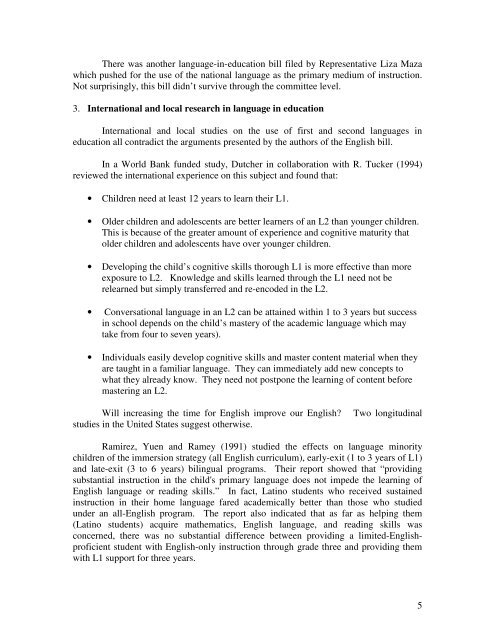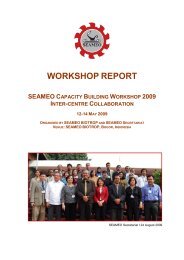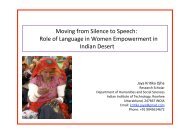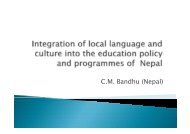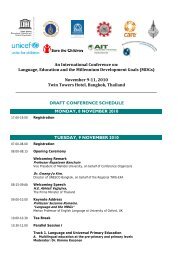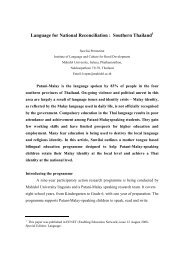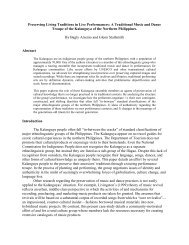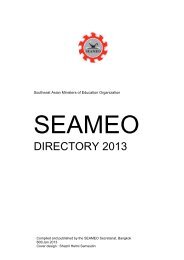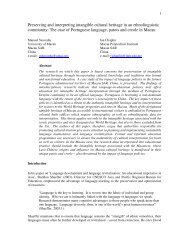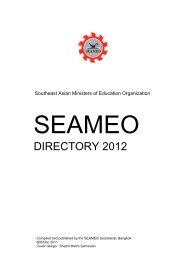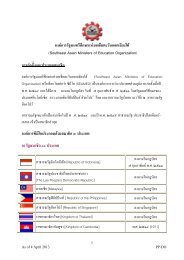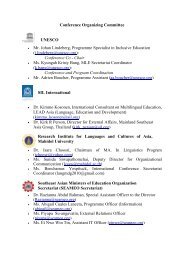THE PROSPECTS OF MULTILINGUAL EDUCATION ... - SEAMEO
THE PROSPECTS OF MULTILINGUAL EDUCATION ... - SEAMEO
THE PROSPECTS OF MULTILINGUAL EDUCATION ... - SEAMEO
Create successful ePaper yourself
Turn your PDF publications into a flip-book with our unique Google optimized e-Paper software.
There was another language-in-education bill filed by Representative Liza Maza<br />
which pushed for the use of the national language as the primary medium of instruction.<br />
Not surprisingly, this bill didn’t survive through the committee level.<br />
3. International and local research in language in education<br />
International and local studies on the use of first and second languages in<br />
education all contradict the arguments presented by the authors of the English bill.<br />
In a World Bank funded study, Dutcher in collaboration with R. Tucker (1994)<br />
reviewed the international experience on this subject and found that:<br />
• Children need at least 12 years to learn their L1.<br />
• Older children and adolescents are better learners of an L2 than younger children.<br />
This is because of the greater amount of experience and cognitive maturity that<br />
older children and adolescents have over younger children.<br />
• Developing the child’s cognitive skills thorough L1 is more effective than more<br />
exposure to L2. Knowledge and skills learned through the L1 need not be<br />
relearned but simply transferred and re-encoded in the L2.<br />
• Conversational language in an L2 can be attained within 1 to 3 years but success<br />
in school depends on the child’s mastery of the academic language which may<br />
take from four to seven years).<br />
• Individuals easily develop cognitive skills and master content material when they<br />
are taught in a familiar language. They can immediately add new concepts to<br />
what they already know. They need not postpone the learning of content before<br />
mastering an L2.<br />
Will increasing the time for English improve our English?<br />
studies in the United States suggest otherwise.<br />
Two longitudinal<br />
Ramirez, Yuen and Ramey (1991) studied the effects on language minority<br />
children of the immersion strategy (all English curriculum), early-exit (1 to 3 years of L1)<br />
and late-exit (3 to 6 years) bilingual programs. Their report showed that “providing<br />
substantial instruction in the child's primary language does not impede the learning of<br />
English language or reading skills.” In fact, Latino students who received sustained<br />
instruction in their home language fared academically better than those who studied<br />
under an all-English program. The report also indicated that as far as helping them<br />
(Latino students) acquire mathematics, English language, and reading skills was<br />
concerned, there was no substantial difference between providing a limited-Englishproficient<br />
student with English-only instruction through grade three and providing them<br />
with L1 support for three years.<br />
5


